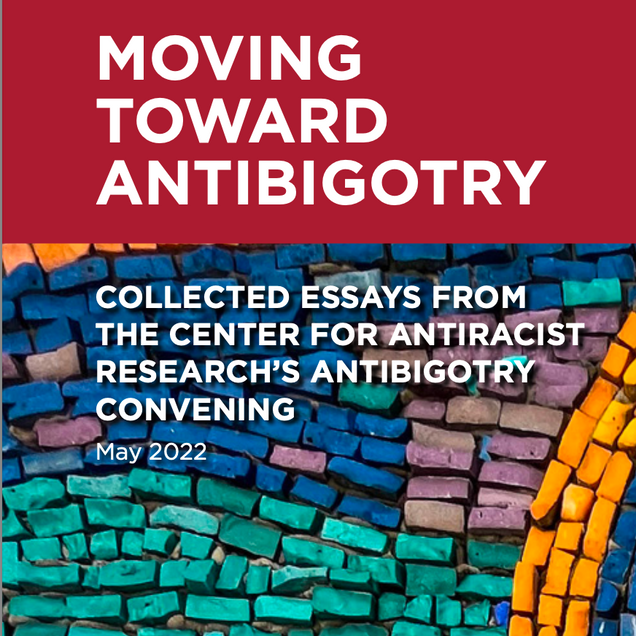Antibigotry Convening
In June of 2022, the BU Center for Antiracist Research released its report, Moving Toward Antibigotry: Collected Essays from the Center for Antiracist Research’s Antibigotry Convening.
This report arises from the Center’s 2021-2022 Antibigotry Convening, which was funded by the Ford Foundation. The Convening brought together thirty-five scholars and advocates (“Antibigotry Fellows”) to consider fifteen categories of bigotry: ableism, ageism, anti-Asian/Asian American racism, anti- Black racism and colorism, anti-fat bigotry, anti-Indigenous bigotry, anti-Latinx racism, anti-Pacific Islander bigotry, antisemitism, classism, heterosexism and transphobia, Islamophobia, linguicism, religious intolerance, and sexism. This report includes essays on each of these categories, independently authored by the Antibigotry Fellows, as well as an essay by the Center faculty and staff who facilitated the Convening.
This Antibigotry Convening Report contributes to public conversations about bigotry by focusing particularly on its structural aspects. While bigotry in the United States is generally explored through individual attitudes and acts, this report examines ways that structural aspects of bigotry—including laws, policies, practices, norms, and narratives—work together with ideas about the alleged superiority and inferiority of particular groups to cause and normalize subordination.
Moreover, this report examines commonalities across categories of bigotry, which may indicate potential points of solidarity for an antibigotry concept and movement. While experiences of bigotry may differ, many expressions of bigotry are interrelated or intersecting, and seemingly isolated expressions of bigotry often produce common harms. Bigotry in all its forms and manifestations serves to consolidate power in a few at the expense of many. Antibigotry means working to disrupt all forms of bigotry, without leaving anyone behind.
We hope this report can support the important work of antibigotry by serving as a resource for advocates, community members, scholars, policymakers, and all who seek a world in which every person is safe, healthy, joyful, and free.
Download PDF of full policy report
Meet the Antibigotry Convening Fellows
-
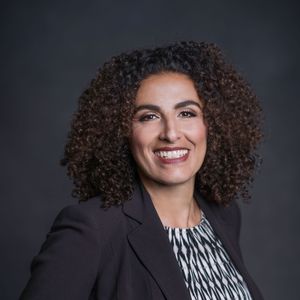
Sahar Aziz
-

Ryan Backer
-
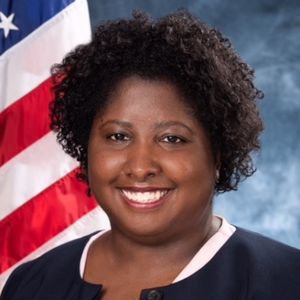
Rabia Belt
-

Khaled Beydoun
-

Saqib Bhatti
-

Megan Black
-
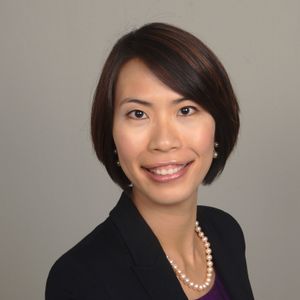
E-Shein (Iggy) Chang
-

Janvieve Williams Comrie
-

John Corrigan
-

Joy Cox
-

Michaé De La Cuadra
-
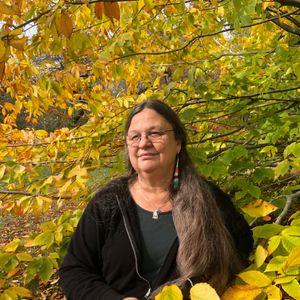
Judy Dow
-

Cynthia Willis Esqueda
-

Terina Kamailelauliʻi Faʻagau
-

Amy Farrell
-

Marc-Tizoc González
-

Heron Greenesmith
-
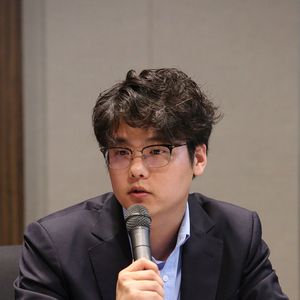
Sungkwan Jang
-

Antoinette Landor
-

Jioni Lewis
-

Kyle T. Mays
-

Reyma McCoy McDeid
-

Keri Leigh Merritt
-

Dalia Mogahed
-

Mark Ramirez
-

Kwyn Townsend Riley
-

Lourdes Rosado
-

Lakshmi Sridaran
-

Jason Stanley
-
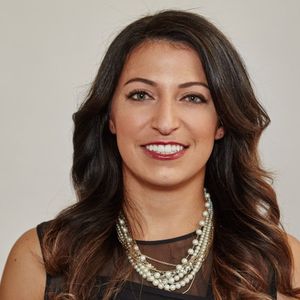
Tyler Press Sutherland
-

Ria Tabacco Mar
-

Ian F. Tapu
-

Amanda Tyler
-

Eric Ward
-

Paul Watanabe
-

Jason Williamson
Check out this video by BU Students Stella Guan and Qiqige Wang, who interviewed some of the Antibigotry Fellows for their Multimedia Storytelling journalism class, taught by Professor Michelle Johnson and Professor John Baynard!
Antibigotry Convening Report Chapters
Each essay represents only the views of its authors, and not the Center or the other contributors to this report.
Introduction
In the Fall of 2021 and Winter of 2022, the Boston University Center for Antiracist Research (“the Center”) brought together thirty-five scholars and advocates for an Antibigotry Convening (“the Convening”) that examined fifteen identified categories of bigotry: ableism, ageism, anti-Asian/Asian American racism, anti-Black racism and colorism, anti-fat bigotry, anti-Indigenous bigotry, anti- Latinx racism, anti-Pacific Islander bigotry, antisemitism, classism, heterosexism and transphobia, Islamophobia, linguicism, religious intolerance, and sexism. Together with this group of “Antibigotry Fellows,” we sought to examine bigotry in the United States from multidimensional, intersectional, and interdisciplinary perspectives. More
Examining Structural Bigotry and Moving Toward Antibigotry (Caitlin Glass, Jasmine Gonzales Rose, Neda Khoshkhoo, Rachael DeCruz, and Selma Hedlund)
We are at a critical moment in U.S. history. As we witness a growing number of laws prohibiting teachers from talking about certain experiences of bigotry, we also see a slew of coordinated physical, verbal, and legislative attacks on communities historically targeted by bigotry. While bigotry manifests in different ways across time, geography, and particular categories, collectively these manifestations consolidate power in insiders. Through this Antibigotry Convening Project, we have endeavored to identify common harms across categories of bigotry, which may indicate potential points of unity for an antibigotry concept and movement. More
Ableism (Rabia Belt)
What is ableism? According to the dictionary, it is “discrimination or prejudice against individuals with disabilities.” Yet this definition confounds as much as it explains. What is discrimination or prejudice? What is a disability? Scholars and activists who study and challenge ableism recognize that though disability, how it is defined, and who is captured by the term varies in time and place, the through line is about the meaning made of bodily difference. And that some bodily differences – and some people – are valued as less than others. More
Ageism (Ryan Backer and E-Shien (Iggy) Chang)
Ageism is one of the most invisible and yet pervasive forms of bigotry. We define ageism as the systematic stereotyping, prejudice, and discrimination against individuals based on their age. Bigotry, in the context of ageism, is the manifestation of a collective ill-will directed at less-privileged groups which systemically manipulates, degrades, and denies the dignity and autonomy of individuals within those groups in order to maintain perpetual dominance over them. There are three key manifestations of ageism as a persistent form of bigotry: cognitive (stereotypes), affective (prejudice), and behavioral (discrimination). More
Anti-Asian American Racism (Paul Y. Watanabe and Sungkwan E. J. Jang)
Asian Americans have suffered from racism ever since arriving in the United States over 200 years ago, including through harassment, violence, and discrimination. Racism is perpetrated by individual actors, businesses, and institutions, as well as public policies and government actions on the local, state, and federal levels. Racism targeting those of Asian descent draws from other forms of bigotry, such as xenophobia, nativism, linguicism, fetishization, and objectification. Anti-Asian American racism is not only borne of, but also perpetuated by the “mutual reinforcement” between public policy and cultural ideas. More
Anti-Blackness/Colorism (Janvieve Williams Comrie, Antoinette M. Landor, Kwyn Townsend Riley, and Jason D. Williamson)
Anti-Blackness is defined as the beliefs, attitudes, actions, practices, and behaviors of individuals and institutions that devalue, minimize, and marginalize the full participation of Black people —visibly (or perceived to be) of African descent. It is the systematic denial of Black humanity and dignity, which makes Black people effectively ineligible for full citizenship. The Anti-Blackness paradigm positions Blackness as inherently problematic, rather than recognizing the long, rich, and diverse history of Black people throughout the African diaspora, and acknowledging that Black communities across the United States (and the world) have been severely disadvantaged as a result of historical and contemporary systemic racism. More
Anti-Fat Bigotry (Joy Cox and Amy Erdman Farrell)
Anti-fat bigotry is a deeply embedded form of bigotry that spans centuries of Western history. Rooted in the histories of 18th and 19th century race science and concepts of “civilization,” anti-fat bigotry today often hides behind a cloak of “health concern” that works to legitimize processes of discrimination and oppression of fat people. While everyone feels the effects of anti-fat bigotry, larger-bodied women, people of color, and poor people particularly bear the brunt of its negative consequences, which work in tandem with many other forms of oppression. The ill-effects of anti-fat bigotry get played out in every arena of life: health care, housing, education, business, and interpersonal and family relationships. Today, anti-fat bigotry is kept in deep-seated and often invisible anti-fat ideology that works in tandem with a diet and weight loss industry that tops almost $80 billion a year in the United States. More
Anti-Indigenous Bigotry (Judy A. Dow)
Bigotry has been a part of Indigenous People’s lives since the arrival of Europeans. Here in Northern Vermont, New Hampshire, and Maine the story is slightly different than much of Northeastern America because our first interaction was with the people trying to establish New France (Canada). First meetings began with the Norse about 900 BP (some say even earlier). In America for the most part, we are talking about contacts being a little over 400 years ago. The tactics used to steal the land were not necessarily the same as those used in America, but the purpose and results were the same: theft of land, and slow elimination of Indigenous People by assimilation or marriage. More
Anti-Indigenous Bigotry (Kyle T. Mays)
In the 1820s, French aristocrat Alexis de Tocqueville traveled throughout the young United States documenting how democracy functioned in this new society. Traveling from the Northeast to the Deep South, this deep ethnography of a nation-state and the meaning of democracy would be published in the now important, Democracy in America (1835). While historians and political theorists repeatedly cite the many pages in which he discusses political theory, they often ignore the importance of the chapter on the three races; that is, how Tocqueville believed Black, Indigenous, and white Americans would live collectively on this land. He didn’t think that it was possible long-term. Tocqueville concluded that Black people would forever be oppressed and Indigenous peoples would ultimately disappear because white Americans deemed both of these groups as inferior. Unfortunately, the ongoing discourse of Indigenous peoples’ inevitable disappearance remains a core feature of American life. More
Anti-Latinx Racism (Mark D. Ramirez and Lourdes M. Rosado)
Latinx people are the second-largest racial or ethnic group in the U.S. During the last decade, the Latinx community accounted for about 50 percent of the nation’s population growth according to the United States Census Bureau. In 1976, the U.S. Congress passed Public Law 94-311, recognizing Americans of Spanish origin or descent as anyone tracing their ancestry “from Mexico, Puerto Rico, Cuba, Central and South America, and other Spanish-speaking countries.” Today’s Latinx population in the U.S. roughly encompasses these same populations, although “Latinx” commonly refers to a subjective pan-ethnic identity that coexists alongside identification with national origins as well as potentially other racial and nationalist group identities. More
Anti-Pacific Islander Bigotry (Ian Falefuafua Tapu and Terina Kamailelauli‘i Fa‘agau)
This discussion begins by acknowledging its limits. First, the term “Pacific Islander” commonly functions as a catch-all, referring to any Indigenous Peoples of Oceania, including inhabitants and diaspora. By grouping together politically and culturally distinct Peoples into a single ethnic/racial category, the term is overbroad and often problematic. We adopt this terminology in this report, but we also dissect the “Pacific Islander” category to highlight the diverse experiences of Pacific Islander communities. Second, this report is written in a language that has historically been deployed, with other settler-colonial tools, against Indigenous Peoples to dispossess them of their ancestors’ tongue and their connection to family, culture, and lands. Although relayed in English, this report nonetheless centers our Pacific Islander communities and values. More
Antisemitism (Megan Black and Eric Ward)
Even as racism and other forms of bigotry are at the center of our national debate, there is so little understanding of one widespread form of bias that The Atlantic recently published an article titled “Why So Many People Still Don’t Understand Anti-Semitism.” We don’t even have consensus on how to spell what we need to talk about; whether or not to hyphenate or capitalize. Anti-Semitism or antisemitism? As we explain below, many aspects of antisemitism are misunderstood. Our purpose here is to help expand the focus of antibigotry activists to understand the relationship of antisemitism to other forms of bigotry. More
Classism (Saqib Bhatti and Keri Leigh Merritt)
“You are kept apart so that you may be separately fleeced of your earnings,” the famous Georgia populist leader Tom Watson told a crowd of Black and white laborers in 1892. Elite whites established and perpetuated segregation between the poor of all races, he argued, to their own economic benefit. “You are deceived and blinded that you may not see how this race antagonism perpetuates a monetary system which beggars both,” Watson rightfully crowed. More
An Abundant Queer and Trans Future: Free From Heterosexism and Transphobia (Heron Greenesmith, Kwyn Townsend Riley and Michaé De La Cuadra)
It is a painful exercise to answer the questions “how do heterosexism and transphobia manifest,” and “which laws and systems perpetuate bigotry against queer and trans people.” It is painful because we, the authors of this section of the report, are queer and trans people who, like queer and trans people across the country and the world, are continually forced to justify not only our existence, but also to prove that we face structural and interpersonal bigotry. The discrimination of queer and trans people is a recent, post-colonial phenomenon. In many indigenous societies in the past, trans people were seen as pillars to society and as spiritual beings, but due to the rigid nature of the gender binary and how this has been forced on the world in a non consensual manner, this has subsequently demonized and criminalized queer and trans people. More
Islamaphobia (Sahar Aziz, Khaled A. Beydoun, Dalia Mogahed and Lakshmi Sridaran)
The attacks of 9/11, and the U.S. government’s response known as the “Global War on Terror” that followed, positioned Muslim identity as the focal target of the national security state. The consequences have been characterized, understood, experienced, and named by grassroots communities and leaders to include not just the unjust foreign wars and interventions that the U.S. has waged under the Global War on Terror, but also the racial profiling, surveillance, spying, detention, and deportation our government has inflicted on Muslim, Arab, and South Asian communities in the U.S. In swift fashion, the Bush Administration restructured the national security, immigration and tracking apparatuses of the state, consolidated into the newly minted Department of Homeland Security (DHS). More
Linguicism (Cynthia Willis Esqueda and Tyler Press Sutherland)
Linguistically, the United States has a peculiar past and a changing future. Despite the official establishment of a United States government in 1787, England was still the “mother” country and English language was part of that legacy. The United States constitution has no language requirement, since the early framers of the government were aware of past monarchial language restrictions, and they were aware that language promoted freedom of thought. The United States, then, was formed from many national sources and languages. Hence, the “English” spoken in the United States today is a hybrid, with terms and phrases from around the world. However, only 8.3% speak English less than well in the United States. More
Religious Intolerance and Structural Bigotry in the U.S. (John Corrigan and Amanda Tyler)
Monotheistic religion is the oldest and most encompassing framework for bigotry in the West. Its Manichean binaries of good and evil, pure and impure, superior and inferior, us and them have been leveraged over centuries to justify bigotry. That ideology of stark division and uncompromising difference has survived in spite of the powerful prophetic traditions of those same Abrahamic religions urging social justice, compassion, and peace. Bigotry has been installed in religious institutions in the West for millennia, but at the same time, those institutions have authorized power to undermine bigotry. They have contributed crucially to the fashioning of counter-ideologies aimed at liberation from narrow views of human subjectivity and social life that engendered suffering. The problem of religious bigotry then, is a complex one, tied to spatial and temporal contexts, and frequently admitting a measure of ambiguity. More
Sexism (Jioni A. Lewis and Ria Tabacco Mar)
The COVID-19 pandemic has put women at the center of the most unequal recession in modern American history. In addition, women of color are more likely to work in frontline service jobs that lack the ability to work from home, which has put them at increased risk of COVID-19, and in turn are more likely to lack paid sick leave when they do contract the virus. Yet the unique experiences of women with intersecting forms of marginalization have often been invisible throughout this pandemic. More
